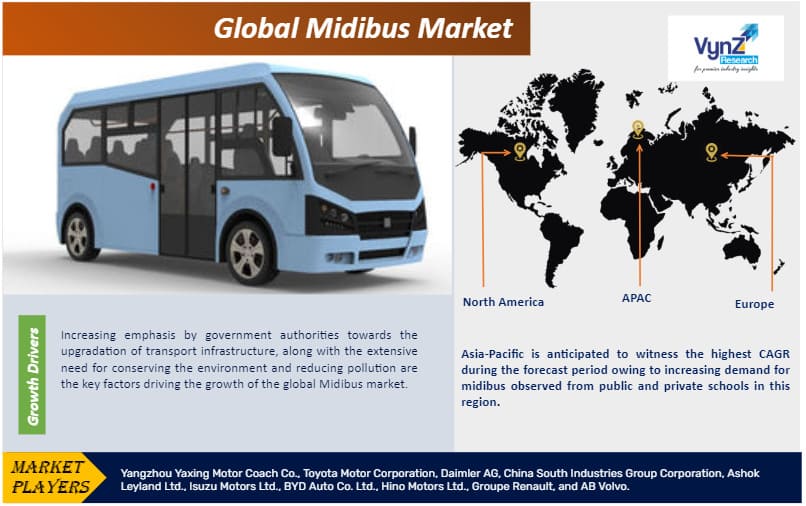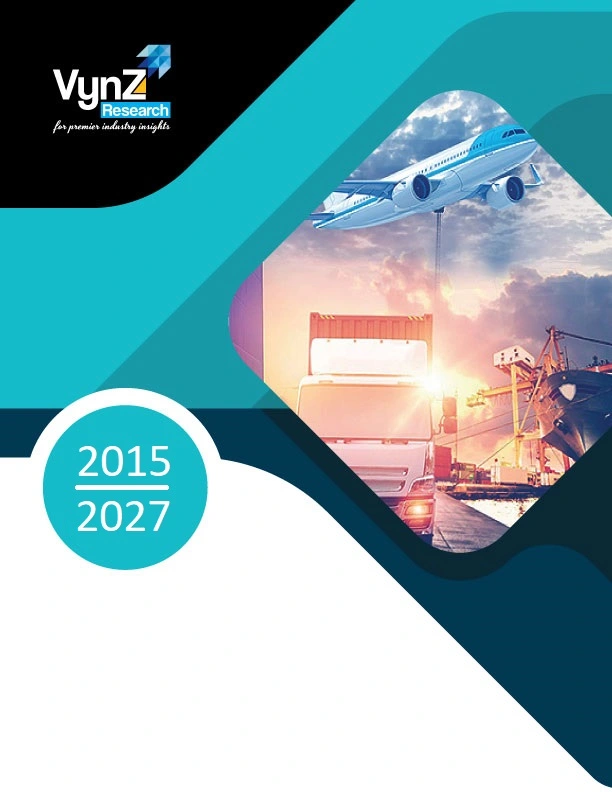Industry Overview
The Global Midibus Market is forecast to grow at a CAGR of 5.5% between 2025 and 2030. The growth of this market is attributed to the increasing population, rapid urbanization along with increasing expenditure attributed to the upgradation of public transport vehicles. With the increasing trend of the sharing economy, people have started using more public transport that provides that significant cost efficiencies and convenience of traveling. Moreover, the 10-meter size of buses is gaining significant popularity as not being huge or too small and this effectively serves the needs of an individual to travel conveniently whether intercity or intracity.

A midibus is a category of single-decker minibus that are generally larger than a traditional minibus on the other hand smaller than a full-size single decker that could be around 8 metres to 11 metres long. The midibuses are most commonly utilized in the U.K. where people find it a cost-effective method and have a significant number of seats in comparison to that of full-size single-decker buses. Midibuses are designed in a manner so that they are lightweight and help in saving diesel fuels thereby making them not as resilient in comparison to that of full-size buses.
Midibus Market Segmentation
Insight by Propulsion
Based upon propulsion, the global midibus market is subdivided into electric, gasoline, natural gas, diesel, and hybrid. Amongst all these segments, the electric bus segment is expected to witness the highest CAGR during the forecast period as almost all countries in the world are using buses backed by natural gas thereby creating ample pollution and causing damage to the environment.
Insight by End User
Based on end users, the global midibus market is subdivided into intracity, intercity, and others. Amongst these segments, the intercity segment is expected to witness the highest CAGR during the forecast period owing to the use of midibus excessively being used for shorter distances specifically in the Asia-Pacific in countries such as China and India.
Global Midibus Market Report Coverage
|
Report Metric
|
Details
|
|
Historical Period
|
2018 - 2023
|
|
Base Year Considered
|
2024
|
|
Forecast Period
|
2025 - 2030
|
|
Market Size in 2024
|
U.S.D. XX Billion
|
|
Revenue Forecast in 2030
|
U.S.D. XX Billion
|
|
Growth Rate
|
5.5%
|
|
Segments Covered in the Report
|
By Vehicle Type, By Application
|
|
Report Scope
|
Market Trends, Drivers, and Restraints; Revenue Estimation and Forecast; Segmentation Analysis; Impact of COVID-19; Companies’ Strategic Developments; Market Share Analysis of Key Players; Company Profiling
|
|
Regions Covered in the Report
|
North America, Europe, Asia-Pacific (APAC), Rest of the World (RoW)
|
Industry Dynamics
Midibus Market Growth Drivers
Increasing emphasis by government authorities towards the upgradation of transport infrastructure, along with the extensive need for conserving the environment and reducing pollution are the key factors driving the growth of the global midibus market. The developed nations are emphasizing using a low-carbon economy that will not hurt the environment significantly. Moreover, the enhancement of the transportation systems in the EU emphasizes making transport in the region cleaner, sustainable, and energy-efficient. Additionally, midibuses comprise long first gear that eliminates the need for using a second and also provides a comfortable ride to the passengers. These buses comprise of a topology-dependent gear that helps the driver in matching the transmission power in various driving conditions.
Midibus Market Challenges
However, the lack of control centers and command that leads to high traffic congestion in metropolitan areas leads people to adopt other modes of public transport such as mass rapid transit such as the metro or subway, and is the key factor anticipated to hamper the growth of global midibus market shortly.
Midibus Market Geographic Overview
Geographically, Europe was the largest midibus market in 2020. The initiative undertaken in Europe related to the clean bus deployment initiative was launched in 2017 by bus manufacturers, consigners, stakeholders, and public transport organizations from various cities across Europe which has massively accentuated the growth of the midibus market in this region.
Moreover, Asia-Pacific is anticipated to witness the highest CAGR during the forecast period owing to increasing demand for midibuses observed from public and private schools in this region. The increasing population in the region is leading to increasing demand for schools in emerging economies such as Thailand, China, Indonesia, and India that is increasing demand for midibus in the region. Furthermore, it has been observed that few routes in Hong Kong are served exclusively by midibus due to twisting roads and are thereby ensuring increased flexibility and running of traffic.
Midibus Market Competitive Insight
Key players operating in the global midibus market are emphasizing their efforts upon strategic acquisitions in order to strengthen capabilities of research & development that support them in providing innovative solutions to the users and thus gain competitive advantage.
Yangzhou Asiastar Bus Co., Ltd is a bus manufacturer based in Yangzhou, Jiangsu, China. It is a subsidiary of Jiangsu Yaxing. The company's brands include Yaxing, Yangtse, Eurise and AsiaStar.
Toyota Motor Corporation is a Japanese multinational automotive manufacturer headquartered in Toyota City, Aichi, Japan. Toyota is the largest automobile manufacturer in the world, producing about 10 million vehicles per year.
Some of the major players operating in the global midibus market are Yangzhou Yaxing Motor Coach Co., Toyota Motor Corporation, Daimler AG, China South Industries Group Corporation, Ashok Leyland Ltd., Isuzu Motors Ltd., BYD Auto Co. Ltd., Hino Motors Ltd., Groupe Renault, and AB Volvo.
Recent Developments by Key Players
Ashok Leyland has inaugurated a new dealership for Light Commercial Vehicles (LCVs) in Tinsukia, Assam. This is the company’s fourth LCV Dealership in the state of Assam. The new channel partner Bharat Motors has a 3S (Sales, Service, and Spares) facility which is equipped with quick service bays, advanced tools and having sophisticated infrastructure to ensure superior customer experience.
BYD Co Ltd (China) shall set up a new electric vehicle (EV) factory in Mexico, as the EV maker aims to establish an export hub to the United States.
Primary Research
VynZ Research conducts extensive primary research to understand the market dynamics, validate market data, and have key opinions from industry experts. The key profiles approached within the industry include, CEO, CFO, CTO, President, Vice President, Product Managers, Regional Heads, and Others. Also, end user surveys comprising consumers are also conducted to understand consumer behavior.
The Midibus Market report offers a comprehensive market segmentation analysis along with an estimation for the forecast period 2025–2030.
Segments Covered in the Report
- Propulsion
- Electric
- Gasoline
- Natural Gas
- Diesel
- Hybrid
- End User
- Intracity
- Intercity
- Others
Geographical Segmentation
- North America
- Europe
- Germany
- U.K.
- France
- Italy
- Spain
- Russia
- Rest of Europe
- Asia-Pacific (APAC)
- China
- Japan
- India
- South Korea
- Rest of Asia-Pacific
- Rest of the World (RoW)
- Brazil
- Saudi Arabia
- South Africa
- U.A.E.
- Other Countries
.png)
Source: VynZ Research
.png)
Source: VynZ Research




.png)